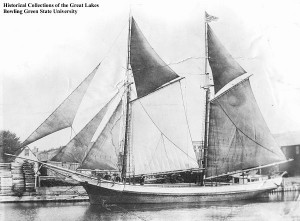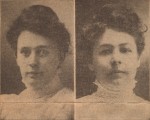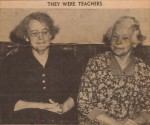The Two Jessie Martins
There were two Jessie Martins, one was a flesh and blood woman born in October of 1873 and the other was a Great Lakes schooner built in Muskegon, Michigan in 1881. This is their story.
The Martins were Scotch-Irish. They emigrated from Northern Ireland about 1819 and came to the U.S. after a brief stop in Quebec. William Martin, Sr., Jessie’s grandfather, arrived in St. Lawrence County, New York married Mary Cady, and helped found the small town of Edwards. Their oldest son, William, was born there in 1829, to be followed by six brothers and sisters. The Martins prospered in Edwards. Family lore says the Martins were all teachers, but town history has William in the hotel and distillery business. I expect there was more money to be made from whisky than from education. The merits of a fine bottle of Scotch and a fine education are hopefully not mutually exclusive and William may have done some teaching as well.

Whatever their occupations in Edwards the family moved on to Michigan about 1855. William, Jr. met and married Rosa Blood and they settledin Muskegon where their first child, Jessie, was born. In 1881 William commissioned Henry Footlander to build a Great Lakes schooner. Great Lakes shipping was a booming business. The ships delivered supplies all around the lakes from Chicago northward. They carried lumber and ore for manufacturing and food and other supplies to growing towns and cities. William named his schooner after his oldest daughter, Jessie.
Things went well until Nov. 23, 1882 when disaster struck. The ship ran aground, but was not seriously damaged and the crewmembers were all safely removed. On Nov. 30, William Martin engaged John Dibble to pull the ship off. Here is an abbreviated account of what ensued from local newspapers

“At ten o’clock the tug, then lying abreast of the south pier, steamed away, the tow-line tautened, and the schooner came off the beach with a plunge, and seemed to stand on end between the seas, the water meanwhile bursting upward and madly sheeting all over her. The next instant she plunged downward, covered with foam and spray, then mounted again bow up, as though she were going to leave the sea, the breakers still scattering over her, and continued her progress in this way under the strain of the tow line, striking the bottom so heavily with each descent as to jar all her timbers, and make the men on board afraid her masts would be unstepped and thrown out of her….What ensued was as speedy as awful. The wretched vessel, lolling in the trough of the seas, so full of water as to be without buoyancy, pushed by the gale upon her port side and pulled by the towline upon the other, instead of coming around under the strain, was simply dragged down and rolled over like a log to starboard, settling upon her bulwarks until her masts lay in the water. As she toppled, the sea burst all over her hull in a furious cascade, and her hatches fell off and floated away. The men aboard as she capsized scattered out into her rigging in a wild scramble for their lives. Encumbered by their clothing, their struggles on an overturning ship, in the whirl of dying water, were of necessity terrible. Three reached the main shrouds, two got to the fore cross-trees and one to the main. The remaining man, Mr. Dibble, had been in the passageway alongside the cabin on the starboard side, and the men in the shrouds could see him, near the surface of the water in that region, vainly trying to climb the main boom. As he had but one arm, and was hampered by the abundance of his clothing, his efforts were ineffectual. For a short time he moaned and struggled in the water., but gradually the sounds and motions ceased, and he slowly drowned.”
A truly heroic rescue followed, saving all of the remaining men.
The ship was eventually pulled to shore, but for William Martin this was a catastrophic loss. The family fortunes never recovered from the loss of the Jessie Martin.
The Jessie Martin was sold to Charles Christensen of Wisconsin. On August 18, 1908 she was carrying a load of lumber when a gale struck off of Ludington, Michigan. The ship sprung a leak, the hull was broken in two and the Jessie Martin sank. She remains on the bottom of Lake Michigan to this day.
In 1885 the Martin family moved to Oregon and settled in Dayton where William Martin tried to find work and 12-year-old Jessie tried to continue her education. In an article in the Capitol Journal of Salem, Oregon Jessie remembered, “that in those days there was an unwritten rule preventing a ninth grade in the schools. The pioneers felt if a person wanted more education than eighth grade he should get out and earn it. We had a teacher in Dayton who gave us ‘bootleg’ education. We would secretly agree some of us, to come to the school at night and he would give us ninth grade algebra and he sneaked in Literature too.”
At the age of 20 Jessie began a long career as a schoolteacher. Her beloved sister Amy soon joined her in the profession. Jessie and Amy Martin never married. The article in the Capital Journal quotes Amy as saying, “Jessie had plenty of chances to get married too” and Jessie as saying, “I decided to take my chances alone. After you marry old Harry takes place sometimes.” I have no idea who old Harry is or what he might do, but it’s a direct quote. Old Harry is mentioned several times in the article; if anyone knows who he is please contact me.

Jessie continued to teach until1931 when she refused to go along with the new methods being used in the public schools. A new movement called progressivism championed by John Dewey and Francis Parker was sweeping across the country. This was all just too new-fangled for Jessie. Never one to remain quiet she refused to go along. There was a hearing where principals and supervisors testified that Jessie was “too old -fashioned.” She was dismissed for insubordination and never worked again. Amy continued to teach and supported her sister.
1954 found the aging sisters impoverished and hoping to find a place in the Methodist home. I quote from the Capital Journal article of 1954, “The Misses Jessie Martin, 80 and Amy Martin, 72 taught for some 80 years. Today they live in a four room tidy house on Lee Street, but they must move soon, because the teaching pension Miss Amy receives, $84.48, is not enough to cover living expenses for both. Other sources of income for the Misses Martin are precarious. The sisters sometimes rent a small house at $40, but taxes and upkeep prevent a steady income. The Misses Martin have decided to enter the Methodist home and to acquire the necessary fee they hope to sell both the houses. Wistfully Miss Amy spoke: ‘I always hoped we could have a place of our own to spend the rest of our lives, but I imagine it will be better this way. I won’t break as many bones and Jessie won’t have to work so hard.”

Amy and Jessie did move to the Methodist home where Jessie died in 1959. In her last letter to my mother-in-law Amy speaks of Jessie’s memorial service, “She deserved all that was said of her and more. In fact she had the best disposition of any member of the Martin family. She was loyal and generous and kind. There were so many things she would have liked to do but lack of money was the drawback for all of us.’ ”
Amy lived on for another 23 years and died at the age of 101. Their story ended so sadly, certainly not what William Martin envisioned when he christened a schooner named after his oldest daughter one bright day on the shores of Lake Michigan.
Photo of the Schooner Jessie Martin courtesy of Historical Collections of the Great Lakes, Bowling Green State University”

Leave a Reply